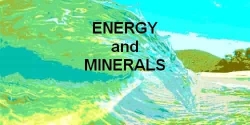Vein Deposits
Vein Deposits
source http://www.tukangbatu.com/2015/12/classification-of-quartz-textures-in.htmladapted into HTML from notes from The Prospecting School on the Web Tom Schroeter, Senior Regional Geologist, Geological Survey Branch, B.C.Ministry of Energy & Mines
adapted into HTML from notes from The Prospecting School on the Web modified from notes by Christine Norcross
http://www.bedrockdreams.com/2015/02/geological-classification-of-gold_17.html
1.Vein-type Deposits
definitions
mode of formation
characteristics
mineral associations
hypothermal types
mesothermal types
eipthermal types
alteration of vein minerals
other vein types
exploration guide
references
2.Epithermal Vein-type Gold Deposits (with a brief look
at other factors that affect the viability of a gold deposit)
conditions
two fluid types:
LS fluids
HS fluids
mode of deposition
geochemical indicators
grade
distribution of gold
metal by-products
price of gold
location of deposit
processing methods
recovery methods
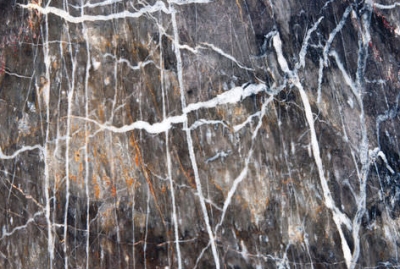
Vein-type Deposits
Definitions
A vein-type deposit is a fairly well defined zone of mineralization,
usually inclined and discordant, which is typically narrow compared to its
length and depth. Most vein deposits occur in fault or fissure openings or
in shear zones within country rock. A vein deposit is sometimes referred to as a (metalliferous) lode deposit. A great many valuable ore minerals, such as native gold or silver or metal sulphides, are deposited along with gangue minerals, mainly quartz and/or calcite, in a vein structure.
A vein system is a group of discrete veins with similar characteristics and usually related to the same structure.
Mode of Formation
As hot (hydrothermal) fluids rise towards the surface from cooling
intrusive rocks (magma charged with water, various acids, and metals in
small amounts) through fractures, faults, brecciated rocks, porous layers
and other channels (i.e. like a plumbing system), they cool or react
chemically with the country rock. Some form ore deposits if the fluids are
directed through a structure where the temperature, pressure and other
chemical conditions are favourable for the precipitation and deposition of
ore minerals. The fluids also react with the rocks they are passing
through to produce an alteration zone with distinctive, new minerals. The presence of intrusive rocks and alteration associated with them provide important guides to prospecting ground for seasoned prospectors. Deposits are often controlled by the physical characteristics of the country rocks. For example, in the Bridge River gold camp, good fissure veins occur in igneous rocks whereas they are poorly developed in sedimentary rocks and serpentine. In the Sheep Creek gold camp, large quartz veins exist in quartzite, whereas in argillite the veins are very narrow. The igneous rocks and quartzites fracture readily while the "softer" rocks do not tend to hold open spaces
Characteristics
Vein deposits include most gold mines, many large silver mines and
a few copper and lead-zinc mines.. Veins commonly consist of quartz (sometimes of several varieties such as amethystine or chalcedony) usually occurring as interlocking crystals in a variety of sizes or as finely laminated bands parallel to the walls of the vein. Minor amounts of sulphide minerals and other gangue minerals such as calcite and various clay minerals often occur; gold is rarely visible.
Veins range in thickness from a few centimetres to 4 metres, the average mining width being around 1.2 metres (e.g. at Bridge River). They can be several hundreds of metres long and extend to depths in excess of 1,500 metres. Mineralization commonly occurs in shoots within the vein structures. These may be up to 150 metres in strike length, 30 metres in width and greater than 250 metres vertical.
Many outcrops of good looking veins are barren of gold or other ore minerals, but rich ore shoots may occur unexposed on surface, either down dip or along strike.
Therefore, geochemical pathfinders are required. These include arsenic, antimony, or mercury which may be enriched in the rocks adjacent to the gold ore, either within the vein structure or in adjacent country rocks, producing a "halo".
Grades of gold historically have been in the 13.7 to 17.1 g/tonne range with cut-off around 8.6 g/tonne. Many more recently developed deposits have larger tonnages and lower grades and can be mined economically thanks to more efficient mining and milling methods. Mining requires adits, drifts, shafts and narrow slopes. If a vein system occurs near the surface it may be possible to mine by open pit methods which would greatly reduce mining costs.
Mineral Associations
- gold with pyrrhotite, e.g. Scottie Gold - gold with arsenopyrite, e.g. Rossland
- gold with pyrite, e.g. Surf Inlet
- gold with chalcopyrite, e.g. Willa
- gold with minor sulphides - classic 'free gold', Bridge River, Toodoggone and Blackdome
- silver with galena and galena-sphalerite, e.g. Slocan District
-silver with tetrahedrite or other copper
- antimony or copper-arsenic sulphides, e.g. Equity Silver
- chalcopyrite, e.g. Churchill Copper, Davis Keays
Lindgren's Classification (1920-30)
Hydrothermal deposits were broadly grouped into three types whose mineralogy and mode of occurrence indicated different conditions of origin:
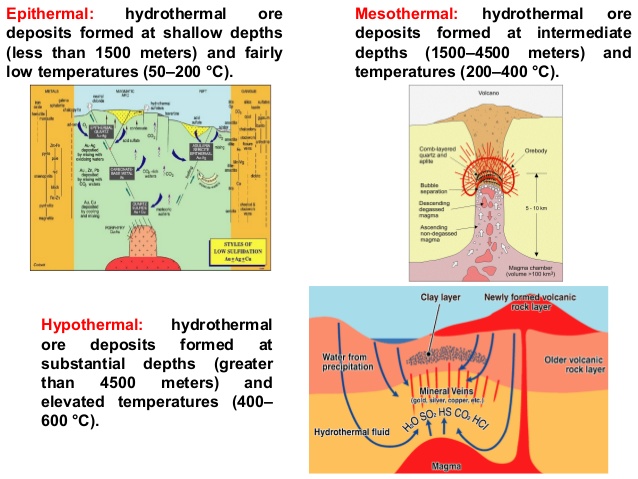
Hypothermal Type
- very high temperatures (300-500°C) and generally at
- great depths (several km) including porphyry copper type deposits
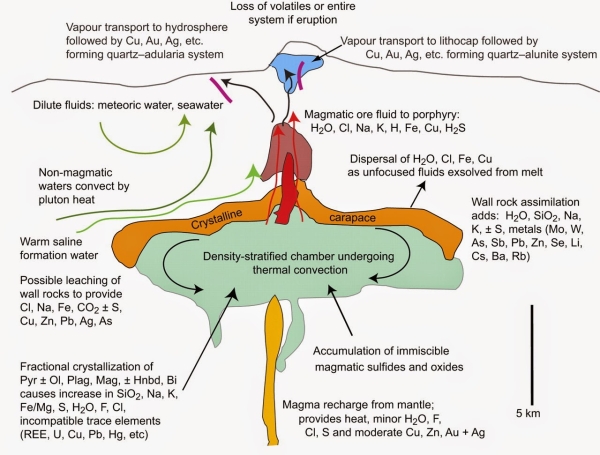
Mesothermal Type Characteristics
Mesothermal type- moderate temperatures (200-300°C) and pressures,
(approximately 1-5 km depth). - sulphides include chalcopyrite, sphalerite, galena, tetrahedrite, bornite and chalcocite.
- gangue includes quartz, carbonates (calcite, siderite, rhodochrosite) and pyrite.
- most show abundant replacement phenomena.
- some associated with ultramafic rocks including listwanites (fuchsite ormariposite (green mica) bearing altered varieties).
- ribbon structures parallel to vein walls.
- includes 'porphyry' copper type deposits.
- extensive alteration zones with varying amounts of sericite, quartz, calcite,doIomite, pyrite, orthoclase, chlorite and clay minerals.
- closely related to igneous rocks, both spatially and genetically.

Epithermal Type Characteristics
Epithermal - comparatively low temperatures (50-200°C). The three
types grade into one another.- deposited normally within 1,000 m (3,000 ft.) of surface; average 350 metres.
- form as vein fillings, irregular branching fissures, stockworks or breccia pipes.
- open space fillings are common and include vugs, drusy cavities, cockscomb textures, crustifications, and symmetrical banding (generally conspicuous).
- colIoidal eextures are characteristic implying free circulation of fluids.
- repeated cycles of mineralization are evident, including rebrecciation and multistage banding.
- in older rocks, these deposits have usually been removed by erosion unless preserved by down faulting, etc.
- majority of deposits are Tertiary in age (esp. SW USA), however, some are much older, e.g. Toodoggone deposits are early Jurassic (approximately 180 Ma).
- wallrock alteration is typically widespread and conspicuous, esp. chlorite, sericite, alunite, zeolites, adularia, silica, pyrite and calcite.
- Ore mineralogy includes: sulfantimonides and sulfarsenides (polybasite, stephanite, pearceite, pyrargyrite, proustite and others), gold and silver tellurides (sylvanite, calaverite and hessite), stibnite, argentite (acanthite), cinnabar, native mercury, electrum, native gold, native silver, selenides and minor galena, sphalerite and chalcopyrite.
- Gangue mineralogy includes quartz, amethyst, chalcedony, adularia, calcite, rhodochrosite, barite, fluorite and hematite.
- striking analogies to modern hot springs.
- Often so diluted with ground water that mineral content is quite low (typical striking analogies to modern hot springs
- Often so diluted with ground water that mineral content is quite low (typical sinters); however, some do contain sulphides and free gold, e.g. Steamboat Springs, Nevada. *deposits are formed in extensional tectonic settings with local normal faulting
- large scale volcanic collapse structures.
- veins are never uniformly mineralized along strike. generally less than 20% of the total vein is mineralized.
- vertical zoning is common
- andesites are more common country rocks.
- economically, deposits are attractive because they have a high unit value of precious metals (esp. 'bonanza' types) with generally low or no base metals.
Classic examples include: Creede, Colorado; Toodoggone Camp, B.C.; Blackdome, B.C.; Premier, B.C.; Comstock Lode, Nevada and Pachuca, Mexico.

Alteration of Vein Minerals
Sulphide minerals oxidize readily to sulphates, many of which are
soluble in water. The result is that weathered outcrops contain no sulphide, i.e. a gossan whereby the metalliferous material has been removed in solution and redeposited at greater depths.
If the zone of groundwater is reached a phenomenon called secondary enrichment may occur.
Silicification is the key alteration associated with internal mineralization flanked on one or both sides by argillic (clay minerals) alteration and an outer extensive propyllitic (chlorite, calcite, epidote, pyrite) alteration.
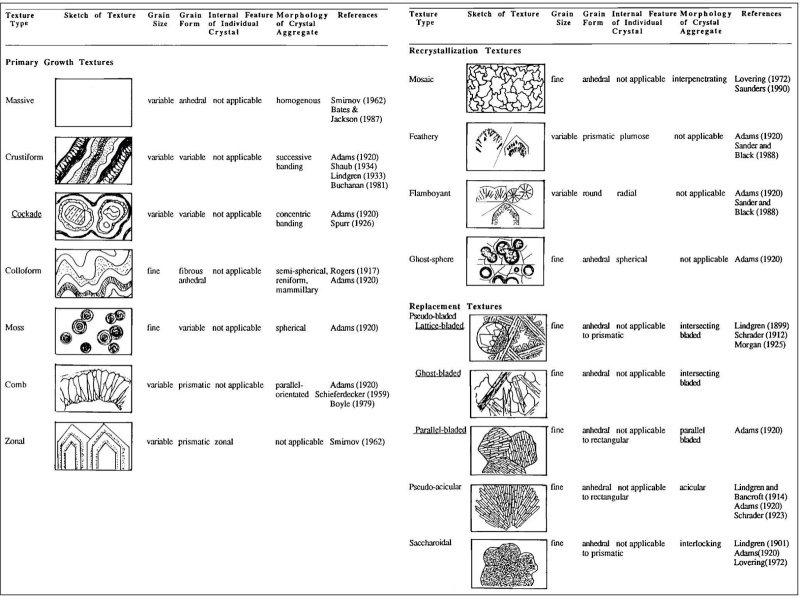
Other Vein Deposits
asbestos , e.g. Cassiar Asbestos 'saddle' veins - on
crests' of anticlines and domes, e.g. Sheep Creek calcite veins - important sources of silver at Cobalt, Ontario shear zone veins
often long, linear belts such as Bralorne-Pioneer system and Yellowknife, N.W.T.
Exploration Guides
1.A suitable fracture or plumbing system must be identified, i.e.
tectonic terrane. 2.A zone of high silica + clays + pyrite may indicate a vein system at depth, i.e. represents a good; drill target.
3.Trace element geochemistry provides pathfinders to mineralization, esp. arsenic, antimony, mercury, thallium and selenium.
4.Detailed mapping of alteration both on the hanging-wall and footwall to indicate possible direction to mineralization.
5.Basic indentification of 'ore' and gangue mineralogy both in the field and in the laboratory (assay, X-ray, etc.).
References
Barr, D.A ., 1980, Gold in the Canadian Cordillera: Canadian
Institute of Mining and Metallurgy Bulletin v. 73, n. 818, p. 59-76. Berger, B.R ., 1982, The geological attributes of Au-Ag-base metal epithermal deposits, In Erickson, R.L., compiler, -Characteristics of mineral deposit occurrences: U.S. Geological Survey, Open-File Rep. 82-795, p. 119-126.
Berger, B.R., and Eimon, P.I ., 1982, Comparative models of epithermal gold-silver deposits: AIME Preprint 82-13, p. 25.
Buchanan, L.J ., 1981, Precious metal deposits associated with volcanic environments in the southwest,
Dickinson, W.R. and Payne, W.D., editors , Relations to tectonics of ore deposits in the southern Cordillera: Arizona Geol. Soc. Digest, v. XIV, p. 237-262.
Colvine, A.C. et al , 1984, An integrated model for the origin of Archean lode gold deposits: Ontario Geological Survey, Open File Rep. 5524, p. 98.
Ney, C.S ., 1975, Mining and Prospecting Notes in Prospecting and MiningSchool, Notes for Prospectors, B.C. and Yukon Chamber of Mines, p. 31.
Panteleyev, A., 1986, A Canadian Cordilleran model for epithermal gold-silver deposits, in Geoscience Canada: Geological Association of Canada, in press.
Schroeter, T.G. and Panteleyev, A ., 1985, Lode gold-silver deposits of the Northern Cordillera: Canadian Institute of Mining and Metallurgy, Spec. Vol., in press.
Epithermal Vein-type Gold Deposits
with a brief look at the factors that affect the viability of a gold deposit
Conditions
An epithermal gold deposit is one in which the gold mineralization occurs
within 1 to 2 km of surface and is deposited from hot fluids. The fluids are estimated to range in temperature from less than 100°C to about 300°C and, during the formation of a deposit, can appear at the surface as hot springs,
similar to those found in Yellowstone National Park (in northwestern Wyoming, southern Montana and eastern Idaho).
The deposits are most often formed in areas of active volcanism around the margins of continents.

Two types of fluids LS and HS
Epithermal gold mineralization can be formed from two types of chemically
distinct fluids - Ä "low sulphidation" (LS) fluids, which are reduced and have a near-neutral pH (the measure of the concentration of hydrogen ions) and
- "high sulphidation" (HS) fluids, which are more oxidized and acidic.
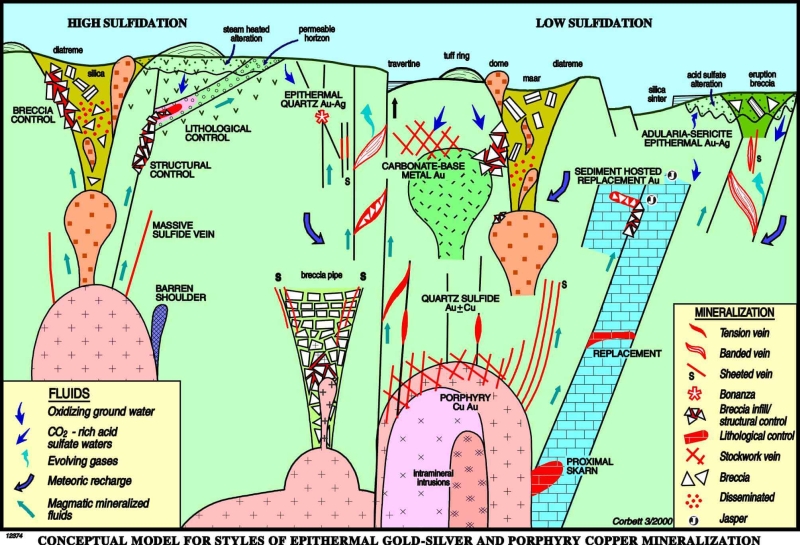
Low sulphidation fluid type
LS fluids are a mixture of rainwater that has percolated into the
subsurface and magmatic water (derived from a molten rock source deeper in
the earth) that has risen toward the surface. Gold is carried in solution and, for LS waters, is deposited when the water approaches the surface and boils.
High sulphidation fluid type
HS fluids are mainly derived from a magmatic source and deposit gold near
the surface when the solution cools or is diluted by mixing with
rainwater.The gold in solution may come either directly from the magma source or it may be leached out of the host volcanic rocks as the fluids travel through them.
Mode of deposition
In both LS and HS models, fluids travel toward the surface via fractures
in the rock, and mineralization often occurs within these conduits. LS
fluids usually forth large cavity filling veins, or a series of finer
veins, called stockworks, that host the gold. The hotter. more acidic HS fluids penetrate farther into the host rock, creating mineralization that may include veins but which is mostly scattered throughout the rock.
LS deposits can also contain economic quantities of silver, and minor amounts of lead, zinc and copper, whereas HS systems often produce economic quantities of copper and some silver.
Other minerals associated with LS systems are quartz (including chalcedony), carbonate, pyrite, sphalerite and galena, whereas an HS system contains quartz, alunite, pyrite and copper sulphides such as enargite.
Geochemical Exploration- indicator elements
Geochemical exploration for these deposits can result in different
chemical anomalies, depending on the type of mineralization involved. - LS systems tend to be higher in zinc and lead, and lower in copper, with a high silver-to-gold ratio.
- HS systems can be higher in arsenic and copper with a lower silver-to-gold ratio.
Location and grade
Many countries have epithermal gold deposits, including Japan, Indonesia,
Chile and the western U.S., each of which occupies a portion of the "Rim
of Fire," the area of volcanism that rings the Pacific Ocean from
Southeast Asia to western South America. Epithermal gold is also found in
British Columbia at the Baker mine, in the Toodoggone district, and near
the Taseko River. Epithermal gold deposits, which contribute significantly to the world's gold supply, are an important exploration target which must be evaluated carefully based on the amount of metal they might provide, and at what cost.
The amount of gold in any type of deposit is calculated based on the ore's grade (the amount of gold per tonne of rock) and tonnage (total number of tonnes) available at that grade.
The higher the grade of the material, the lower the tonnage required to make recovery economical.
A high-grade deposit could have gold values ranging from 10 to more than 150 grams per tonne, whereas a low-grade deposit grades in the range of 1 to 5 grams.
Low-grade deposits may have up to, and possibly more than, 200 million tonnes of rock, whereas a high-grade deposit is frequently smaller.
Distribution of gold within a deposit
Assay results acquired through drilling are important indicators of a
deposit's grade and tonnage. High grades over short distances can be as significant as low grades over longer distances, and both types of deposit can be mined profitably.
Drill results, however, offer only a limited view of a deposit and may be difficult to reproduce.
For instance, a single drill hole may intersect a high-grade zone in an otherwise low-grade (high sulphidation type epithermal) deposit, giving the appearance of a higher grade than actually exists.
Other metals as by-products
Factors other than tonnage and grade come into play in calculating the
economic significance of an epithermal deposit. For instance, the presence of other metals in the ore can increase the value of a deposit, and many epithermal deposits contain a significant silver and/or copper content.
The price of gold
The price of gold (and other metals) is also an important condition in
economic evaluation, as low prices may render small or low grade deposits
uneconomic.A deposit is only "economic" when:
- you can find a buyer
- the selling price gives you a good profit plus covering the costs of mining, extraction, recovery, refining, taxes, environmental rehabilitation
- this situation is projected to continue for the life of the mine
This is why there is some urgency to get an "economic" deposit on-line as soon as possible.
What is profitable today may be "uneconomic" in the future.
The life of a mine is short so investors expect to get a large return early in the life of the mine.
You can't compare mining to the long term life cycle in other business ventures.
Location of deposit
Many epithermal deposits occur in remote regions of under-developed
countries, and the construction of infrastructure, such as roads and
mills, may be necessary before deposits can be mined. These expenses increase the cost of a mining operation and must be taken into consideration when calculating the economics of a deposit.
Mining and processing methods
Mining and processing methods are also important in determining economics.
Since epithermal deposits are often formed at depths of less than 2 km (closer if erosion of overlying material has resulted), many are amenable to relatively less expensive open-pit mining methods.
Deeper deposits that can be exploited only through underground methods are more expensive.

